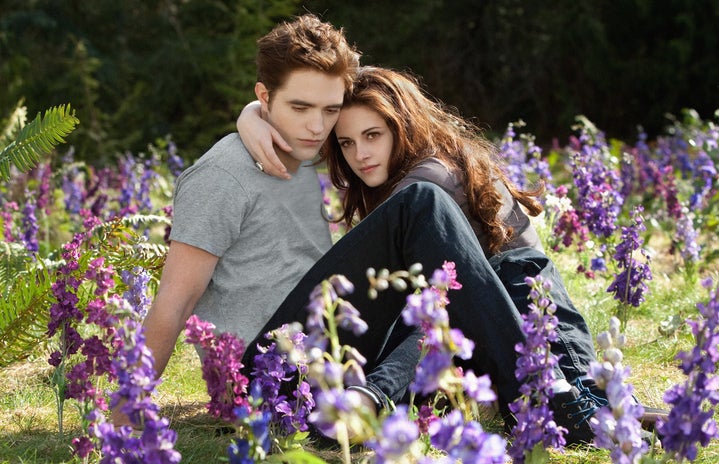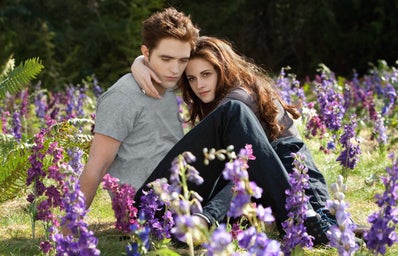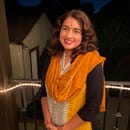In 2005, the first Twilight novel hit shelves, followed three years later by its cinematic adaptation. In the years since the wildly popular vampire romance franchise first sparkled and brooded its way into our lives, it’s experienced a level of cultural hype and conversation to rival that of Harry Potter. But where the tales of the boy wizard are nearly universally regarded as beloved childhood classics, the initial reception to Twilight was markedly different.
I was ten when the first film came to theaters, and I spent my early teens growing up alongside the popularity of the film franchise. Just about everyone around me had an opinion on it. There were, of course, the ‘twihards’ – the super-fans of the series who cheered enthusiastically for Team Edward or Team Jacob and took the stories of the unattainably attractive paranormal residents of Forks, WA, into their hearts. And then there were the ones like me, who needed to let anyone who listened know, in no uncertain terms, how much we hated the series.
Why we hated ‘Twilight’
The discourse around Twilight was divisive from the start, but the overwhelming consensus of the internet could be summed up with “Twilight = bad”. We parroted off the same arguments that had been made a hundred times.
“It’s so creepy that he watches her sleep.”
“Bella has no personality and she’s so boring.”
“Edward’s a 100-year-old stalker.”
“How could anyone like this?”
If you were on Tumblr back then, you probably remember the “still a better love story than Twilight” meme, whose popularity lasted for years. People would gleefully circulate video compilations from interviews to celebrate how much franchise star Robert Pattinson reportedly hated the films. Comments and listicles mocking self-proclaimed Twihards for being generally “cringey” abounded. The general response to Twilight – and those who enjoyed it – was nothing short of vitriolic.
My ten-year-old self, therefore, would probably have been appalled to find that in 2020, I joined the rest of the internet in earnest and unbridled enthusiasm waiting to read Midnight Sun, author Stephenie Meyer’s most recent entry into the series – a retelling of the first book from Edward Cullen’s point of view.
Meyer infamously started writing the novel around a decade ago but abandoned the project when the first twelve chapters of the manuscript were leaked. The leaked chapters became something of fandom lore, with dedicated fans circulating the PDF among themselves (they were also readily available on her website after the leak) and begging Meyer to release the full thing, but as it was labelled indefinitely on hold, all seemed futile. That is until this year, when Meyer created an internet storm by announcing that Midnight Sun would, at least, release in its entirety – a whopping 662 pages – on August 4. The excitement with which the book’s release has been met makes it hard to imagine how embarrassing enthusiasm for the Twilight series was considered some years ago.
Stephanie Meyer Releasing #MidnightSun in 2020pic.twitter.com/OKVAmZhRIn
— Mody (@WildfireKristen) May 4, 2020
My reaction when i saw that #midnightsun will arrive #StephenieMeyer you made my day/quarantine/year ❤❤❤ pic.twitter.com/mVjBD7DwfW
— Stéphanie (@Steph_de_Fr) May 4, 2020
And this widespread affection for the Twilight franchise is something that’s been building rapidly over the last couple of years in a phenomenon that the internet has dubbed “The Twilight Renaissance.” Largely characterized by memes, semi-ironic declarations of love for the franchise and a general nostalgia for people’s Twihard days, this so-called renaissance has given the franchise a new lease of popularity years after it apparently ended.
Related: Being an Adult Shouldn’t Mean I Can’t Still Look Up to Disney Princesses
A major cause for the resurgence of Twilight’s popularity is the fact that the original fans – and detractors – of the series are grown up now, and in a lot of ways, their outlook has changed. In a video essay entitled “Dear Stephenie Meyer”, YouTuber Lindsay Ellis explores the backlash and discourse surrounding Twilight back in the day. She points out that a lot of the reactions to Twilight were rooted in the fact that “we kind of hate teenage girls… and then we wonder why so many girls are eager to distance themselves from being the object of societal contempt.” The franchise’s popularity with a predominantly female fanbase and the ensuing derision towards that fanbase created an environment in which many girls and women felt the need to broadcast their “Twi-hate”, so they could distance themselves from labels like “cringey” and “dumb,” which were applied to the Twihards.
More specific criticisms of the franchise, like the accusations that Bella was a constant damsel in distress or that the central relationship was unhealthy, weren’t exactly untrue (let’s face it, the whole Jacob/Renesmee thing will always be a big fat ‘WTF?’) but the argument that this meant Twilight was a “bad example” is also rooted in misogyny. There have been so many action franchises full of violence and explosions and dangerous car chases, which people are happy to accept at face value as escapist entertainment, because they’re stories aimed at men and boys. When it comes to Twilight, the idea of a female fanbase being able to enjoy an unrealistic or “problematic” narrative purely for the fun of escapist fantasy is suddenly overlooked in favour of aggressive moral posturing that aims to police what girls enjoy.
Having faced such aggressive backlash for so long, it makes perfect sense that now that the original audiences of Twilight have grown up, the original escapism they were mocked for – or would themselves mock – has now resurfaced with a vengeance, combined with the onset of ‘00s nostalgia and meme culture.
We’ve started to reclaim the ‘cringe’
The approach to Twilight has fundamentally changed.
For example, actress Kristen Stewart now openly identifying as gay has encouraged fans to enthusiastically embrace LGBTQ+ readings of the franchise.
A more feminist angle has even been applied to the franchise’s reception, with people not only re-evaluating the reasons behind the initial backlash to the series but celebrating the achievements it did unlock for women. The first Twilight film was not only written by, about and for women, it made director Catherine Hardwicke the most commercially successful female director in Hollywood. Given that opportunities for female filmmakers are still sparse to this day, people have finally recognized this for the achievement it is. There have also been discussions about the injustice of Hardwicke being removed from the rest of the franchise and not reaping major professional benefits despite the resounding success of the first film.
And the outpouring of memes, whether celebrating the series’ iconic soundtrack or its most memorable scenes, represents a rejection of “cringe culture.”
What is your favorite scene in the Twilight franchise and why is it vampire baseball? pic.twitter.com/2w6NcNvm1V
— Prime Video (@PrimeVideo) August 1, 2020
The same content that was cause for shame and ridicule over ten years ago is now allowed to be celebrated openly. People can acknowledge that it’s over-the-top or silly but still have fun with it and enjoy the emotional satisfaction and pure entertainment it provides.
And when we cut to 2020, the year of the pandemic and just about every other sign of an impending apocalypse, the value of art that we can enjoy for the sake of comfort and entertainment and escapism is more significant than ever. The Twilight renaissance and the release of Midnight Sun offer a chance to engage with a nostalgia for the simpler enjoyments of our childhood. Whether by rereading the books, marathoning the movies, sharing the memes or bopping to the soundtracks (seriously, how are they so good?!) we’re able to forget the struggles of the real world and enjoy emotion-driven, earnest, fun media – without feeling like our response to it acts like a judgement on our character, the way it did when we were younger. We can pretend for a while that our world, like the Cullens, has not grown or changed.
But ‘Twilight’ still has its issues
That’s not to say the series should be left uncriticized. Plenty of its content, especially the appropriation and representation of indigenous cultures, is offensive, and it would be irresponsible not to examine that. As Midnight Sun releases, people are encouraging those who buy the books to match that price by donating to the Quileute tribe, whose people and culture have been depicted using incredibly harmful stereotypes about Indigenous people by the series. Descriptions of the Quileute characters as “savage” in comparison to the pale white, “civilized” Cullens as well as the use of completely made-up backstories and lore described as “Quileute legends” to suit Meyer’s world-building were offensive when the series was first written, but the resurgence of interest in Twilight has allowed critiques of these practices to come to the forefront
Discussions of racism have extended to the movies, ever since Catherine Hardwicke revealed that she had wanted to make the overwhelmingly white cast more diverse, but was shot down by Stephenie Meyer.
These are criticisms that can’t be swept aside by explanations of “cringe culture.” They can and should be at the forefront of the discussion as Twilight is re-evaluated. But it’s a lesson in separating genuine criticism from bad faith shaming that these conversations are being given more traction now, when people can discuss the franchise without being shamed as frivolous or stupid, than before, when just liking Twilight was considered an embarrassing enough prospect that many of us went out of our way to declare just the opposite. So as you blast “Bella’s Lullaby” to your heart’s content, remember that we’ve changed the way we talk about Twilight, and that’s a good thing.
You can read the Quileute Tribe’s collection of their own legends here, and donate to their fund to move to higher ground in an effort to escape deadly climate damage here.


